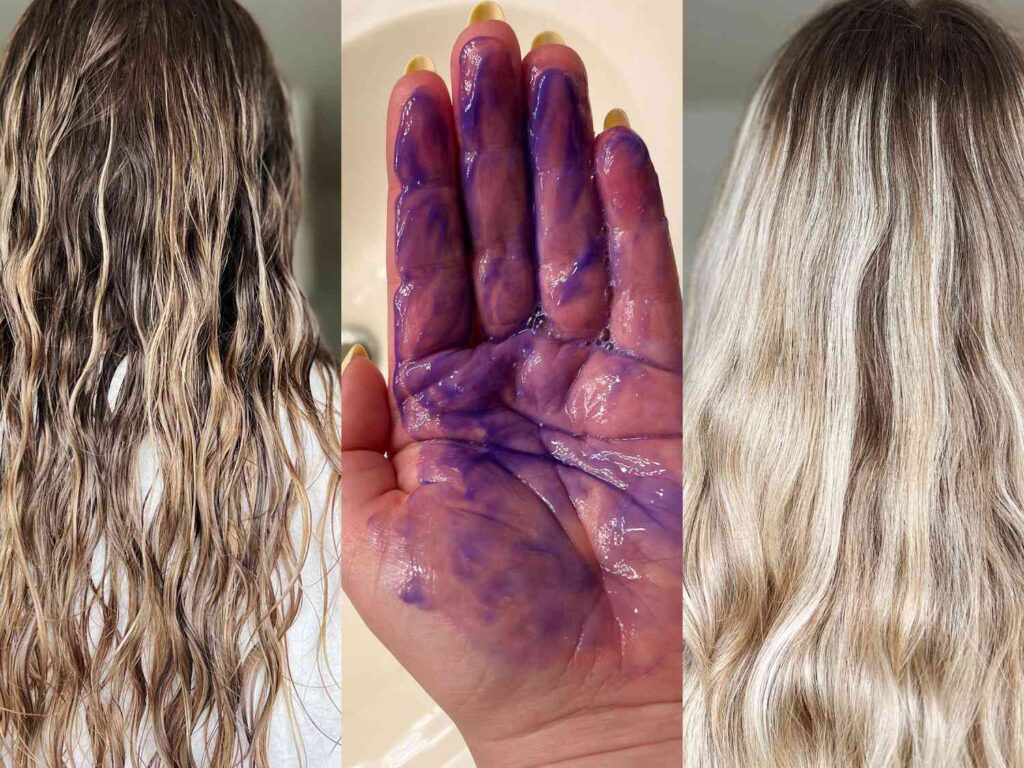Shampoo Matizador: Purple Toning Shampoo for Blonde Hair

Shampoo matizador (also known as purple shampoo, shampoo matizador morado, or shampoo matizador para cabello rubio) is a toning shampoo designed to neutralize unwanted warm brassiness in blonde, platinum, gray, or highlighted hair. Rich in violet or blue pigments, these toning shampoos temporarily cancel yellow or orange tones (“brass”) using basic color theory: violet neutralizes yellow, blue cancels orange. As a result, shampoos marked matizador help maintain cooler shades between salon visits, keeping your hair looking bright, ashy, and vivid.
What Is Shampoo Matizador? Why Does “Matizador” Matter?
In Spanish and Portuguese, matizador literally means “toner”—a product that refines shades by counteracting warm undertones. When you see Shampoo Matizador Preto, matizador violeta, or le black shampoo matizador, you’re looking at a pigmented cleanser that deposits violet or blue hues to cancel brassy undertones.
Typically used on light or bleached hair types, shampoo matizador para cabello rubio gently lifts brightness and neutralizes yellowing. It’s not a color‑lightening product—instead, it deposits pigment, making it more akin to a cleansing toner than a lift or bleach. Nonetheless, it’s ideal for restoring salon‑fresh neutral blondes, grays, and silvers in your shower routine—even shampoo matizador de canas is now gaining popularity for maintaining cool-toned grays.
Why Color Theory Makes It Work
Color theory explains shampoos like shampoo matizador morado or violeta effectively canceling yellow due to their position opposite yellow on the color wheel. That’s why such shampoos are sometimes called “purple shampoos” and target brassiness in blonde or silver hair. By contrast, the less common shampoo matizador azul (blue) is designed to neutralize orange/red tones—making it better suited for deeper brunettes or heat‑oxidation effects.
This logic underlies formulations like Skala’s Hue Matizador (marketed online as Skala Matizador Shampoo): violet or blue dyes deposit into tonally unwanted areas, restoring cool shine to pre-lightened hair.
Who Should Use It (and Who Shouldn’t)
Use shampoo matizador if you have:
Highlighted, bleached, or platinum blonde hair
White or gray hair prone to yellowing
Light balayage or pastel tones that want refreshing
Brassy halos or warmth caused by hard water, sun exposure, or chlorine
Avoid it if you have:
Natural brunette, dark brown, or black hair (the pigment will be invisible or muddy)
Red or copper tones you don’t want to neutralize
Ultra‑fragile or highly porous hair (unless diluted or used sparingly)
Choosing the Right Shade: Purple vs. Blue vs. Violet Black
Purple (matizador morado/ violet) is perfect for canceling yellow tones in blondes and grays.
Blue (matizador azul) is designed to neutralize orange and copper, effective for darker bleached ends or root bands.
Black or “preto” toning shampoos (less common) contain strong violet/blue pigments and may lean extremely neutral—best handled cautiously. Overuse can darken or dull very light hair.
Brands often label their shades according to hair levels:
Purple/purple‑violet: yellow → ash blonde
Blue: orange → cooler blonde or light brown
Black: stronger pigment, for extreme brassiness or aged white hair—but can tint.
Laboratory formulations—such as Bond Angel Blonde Balance Matizador Shampoo or Cadiveu Platinum Matizador—sometimes blend pigments for fine‑tuned toning.
How to Use Shampoo Matizador for Best Results
1. Prepare the hair
Shampoo once with a clarifying or gentle color-safe cleanser if your hair is product‑heavy or in hard‑water areas. Otherwise damp hair is fine.
Warm water helps open the cuticle; finish with cool rinse afterwards.
2. Apply evenly
Wear gloves if pigmented (e.g. violet) products are very saturated.
Distribute evenly from roots to ends (root‑to‑tip application provides more consistent toning).
3. How long to leave on
Natural or mildly brassy blondes: 1–3 minutes
Platinum, bleached, or heavy‑yellow grays: up to 5–10 minutes
Some state “up to 15 minutes” for maximal toning, but expert guidance recommends never leaving it on longer than 30 minutes. Always follow brand instructions.
4. Washing out
Rinse thoroughly until water runs clear.
Never use purple shampoo as your main daily cleanser—use it 1–2 times per week at most; otherwise pigments may build‑up and cause unwanted lavender hues.
5. Follow with moisturizer
Use a regular sulfate‑free conditioner or a toning conditioner if you want an extra pigment dose.
Deep condition within 2 weeks (purple shampoos can strip moisture).
Purple Shampoo vs. Salon Toner vs. Toning Mask — Which Is Better?
Professional toner is typically applied immediately after bleaching using developer (hydrogen peroxide) and lasts few weeks. It imparts permanent/semi‑permanent pigment.
Shampoo matizador (purple shampoo) is a rinse-off tool you use every 1–2 weeks to maintain tone.
Color-depositing masks or conditioners (e.g., violet-blend hair masks) can pigmented more heavily and provide conditioning benefits—but take longer (10+ minutes).
This breakdown helps explain: toner corrects in the salon; purple shampoo maintains at home; toning mask gives deeper pigment plus hydration. Choose based on your hair’s porosity, dryness, and desired longevity.
How Long for Toning to Become Visible?
Generally, you can see dullness or brassy undertones fade after 1–2 uses of purple shampoo. However:
If your hair is porous or previously bleached, pigments absorb quickly—2–3 minute sessions once per week often restore brightness within 1 week.
Very stubborn yellow or oxidation may take 2–3 applications before cool tones appear. Some bloggers report leaving purple shampoo on for up to an hour increases pigment effect—but most pros strongly advise against extended timing to avoid staining.
Potential Drawbacks & How to Avoid Them
| Pitfall | Why It Happens | How to Prevent |
|---|---|---|
| Lavender/purple tint | Over‑toning, especially fine/porous hair | Shorten leave‑on time or dilute |
| Hair becomes dry or brittle | Pigment shampoos often lack conditioning | Alternate with hydrating regimen |
| Uneven toning or spot staining | Uneven application or buildup on ends | Comb through shampoo; rinse thoroughly |
| Too-dry hair due to overuse | Pigments plus surfactants strip oils | Use sparingly; occasionally skip or dilute |
| Hard water or minerals dull tone | Hard minerals cause oxidation | Clarify hair monthly; consider filtered water |
| Incompatible with fresh salon toner | Pigment rush may build up uneven color | Don’t use matizador within two weeks before color correction appointments |
If you experience purple tinting, washing hair 1–3 times with a clarifying shampoo usually removes excess pigment.
Try Xiangxiang Daily Now!
We Help You Launch New Products, And Continue To Grow. Try Us With 20% Off Your First Order!
Pro Tips for Professional‑Level Results
Patch test on a strand—especially if new to violet shampoos—use 1 minute first.
Dilute the product by mixing it with a neutral shampoo if you’re trying it for the first time or if you have fine/light hair.
Don’t combine multiple purple products at once (like shampoo + mask + conditioner on the same wash) to avoid over‑depositing.
Rotate with color-safe, moisturizing shampoos (e.g. L’Oréal EverPure) for normal washes.
Use gloves to prevent staining of hands, nails, and clothing—especially for dark or highly pigmented formulas.
Protect hair from UV, heat, and chlorine—these accelerate brassiness even with toning care.
Weekly masks with keratin or hydrating oils (like coconut or argan) help offset dryness from toning.
Clarify once a month—clear out styling and mineral buildup so pigments deposit more evenly.
Choose the Best Shampoo Matizador for Your Needs
When shopping online—via Amazon, Walmart, BeautyBoxJo, MercadoLibre, or Americanas—you’ll encounter multiple lines labeled as shampoo matizador or toning shampoo:
Look for platinum, violet, or blue toning variations depending on whether you need to neutralize yellow or orange.
Review pigment intensity: more saturated formulas require shorter processing time. Many labels mention processing time (e.g., “3–5 minutes max”).
Consider ingredient lists: prefer sulfate‑free, silicone‑free, and hydrating formulas if your hair is dry. Some Brazilian “matizador preto” shampoos from Salon Line or Skala contain hyaluronic acid and silicones to rehydrate while toning—ideal for fragile strands.
Reading reviews helps determine if a shampoo leans too violet (risk of over¬toning) or isn’t pigmented enough. As noted in a few Reddit discussions, overuse or pairing multiple violet products in one wash can result in a grey or lavender cast.
Summary
In summary, shampoo matizador, commonly known as purple shampoo, is a powerful maintenance tool for anyone with blonde, gray, or highlighted hair. It works by depositing violet or blue pigment to counteract unwanted warm tones. For best results, choose the correct shade (purple for yellow, blue for orange), start with short leave‑on times (1–3 minutes), use it no more than 1–2 times per week, and always pair it with hydrating conditioners or masks. Avoid combining multiple toners in one wash, patch test before first use, and clarify occasionally—this keeps brassiness at bay without over‑drying or over‑toning. Use toning shampoo strategically to extend the brightness of your salon color while protecting hair health.
FAQ
How long does it take for purple shampoo to work?
Noticeable toning typically occurs within 1–2 uses, especially if hair is slightly brassy. More stubborn tones may take several sessions.Will purple shampoo lighten my hair?
No. It deposits pigment—it does not lift color or bleach hair.Should I use toner or purple shampoo?
Use salon toner post-bleach for initial correction; use purple shampoo at home regularly to maintain that tone.Is a purple shampoo or a toning mask more effective?
Shampoo works quickly and lightly; masks deposit more pigment and offer deep hydration—but shouldn’t both be used together in the same wash. Alternate based on dryness and tonality.What if I leave purple shampoo on too long?
Over-exposure (beyond 10–15 minutes) can lead to purple or gray hues, especially on porous hair. Rinse immediately, and tone down with two or more regular shampoos.Do I wash with regular shampoo after purple shampoo?
Typically you rinse it out and follow with a regular conditioner (or purple conditioner); you don’t need a second regular shampoo.Which is better for gray hair, blue or purple shampoo?
Gray or silver hair often benefits more from purple shampoo (counteracts yellow), though blue toner is best when hair leans orange.How often should I wash with purple shampoo?
Start with once per week, then adjust to twice only if still brassy—but don’t overuse.
Table of Contents
Latest Blog Posts
Check out the latest industry trends and take inspiration from our updated blogs, giving you a fresh insight to help boost your business.



